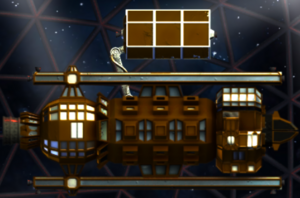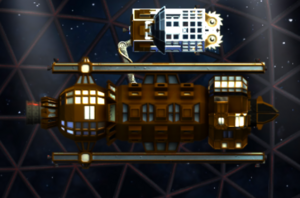(added extra hyperlink) |
(added example image) |
||
| Line 1: | Line 1: | ||
A disambiguation for [[Cradle|cradled]] cargo storage drones. | A disambiguation for [[Cradle|cradled]] cargo storage drones. | ||
[[File:THICC Equipment.png|thumb|A THI Cargo Container fitted to the left hardpoint of a K37]] | |||
== [[THI Cargo Container]] == | == [[THI Cargo Container]] == | ||
| Line 18: | Line 19: | ||
The ejected container will attempt to return to the station with its cargo automatically. | The ejected container will attempt to return to the station with its cargo automatically. | ||
Empty cradle arm can catch drones and lifepods. | Empty cradle arm can catch drones and lifepods. | ||
[[File:THICC Equipment.png|thumb|A THI Monocargo Container fitted to the left hardpoint of a K37]] | |||
== [[THI Monocargo Container]] == | == [[THI Monocargo Container]] == | ||
| Line 38: | Line 40: | ||
The ejected container will attempt to return to the station with its cargo automatically. | The ejected container will attempt to return to the station with its cargo automatically. | ||
Empty cradle arm can catch drones and lifepods. | Empty cradle arm can catch drones and lifepods. | ||
[[File:NT Mining Companion.png|thumb|An NT Mining Companion fitted to the left hardpoint of a K37]] | |||
== [[NT Mining Companion]] == | == [[NT Mining Companion]] == | ||
Revision as of 06:12, 15 October 2024
A disambiguation for cradled cargo storage drones.
THI Cargo Container
Price: 74,000 E$
Cargo capacity: 15,000 kg/mineral Power usage (nominal): 20 MW Cradle mass 500 kg Manufacturer: Titan Heavy Industries
The Titan Heavy Industries Cargo Containers are fully autonomous storage pods that can relay processed minerals from a mining site. When the cradle is powered down, the pod will return to the designated station. These require on-site mineral processing units to utilize. The equipment purchase of the cargo cradle comes with a lease covering the resupply of new pods for as long as the owner holds the license. Station control warns that retrofit with certain RCS configurations may risk overheating the Cargo Container's micro-reactor. Captains assume all such liability.
User Manual
Automatically stores processed ore. You can customize ore stored on Geologist tab. Requires mineral processing unit to be used effectively. Will unbalance the ship if only one is installed. Can be ejected by disabling the hardpoint. The ejected container will attempt to return to the station with its cargo automatically. Empty cradle arm can catch drones and lifepods.
THI Monocargo Container
Price 111,000 E$
Cargo capacity: 90,000 kg/mineral Power usage (nominal): 20 MW Cradle mass 500 kg Manufacturer: Titan Heavy Industries
A single-ore variant of the standard THI Cargo Container for specialized mining runs that focus on the collection of only one mineral type. These require on-site mineral processing units to utilize. The equipment purchase of the cargo cradle comes with a lease covering the resupply of new pods for as long as the owner holds the license. Station control warns that retrofit with certain RCS configurations may risk overheating the Cargo Container's micro-reactor. Captains assume all such liability.
User Manual
Automatically stores processed ore. Can store only one type of ore. You can customize ore stored on Geologist tab. Requires mineral processing unit to be used effectively. Will unbalance the ship if only one is installed. Can be ejected by disabling the hardpoint. The ejected container will attempt to return to the station with its cargo automatically. Empty cradle arm can catch drones and lifepods.
NT Mining Companion
Price: 115,000 E$
Cargo capacity: 50 m^3 Autonomy class: C2 Power usage (nominal): 10 MW Cradle mass 500kg Manufacturer: Nakamura-Titan
In the 23rd century, a joint-venture between Nakamura Dynamics and Titan Heavy Industries produced autonomous mining drones in an attempt to automate ring excavation. While initially successful, drone swarms developed personality quirks in the neural networks with diminished performance over time, with drones engaging in social behaviour rather than excavation. The autonomous mining project was ultimately canceled, but the drones were quietly refurbished and rebranded as Mining Companions, to be sold to independent miners.
User Manual
Deploy by powering down the arm and moving away. Will gather ore automatically. Gathering parameters can be adjusted on the Geologist tab. Returns to the station when full or low on propellant. When attached, grinders are synchronized with your ship. Empty cradle arm can catch drones and lifepods.

